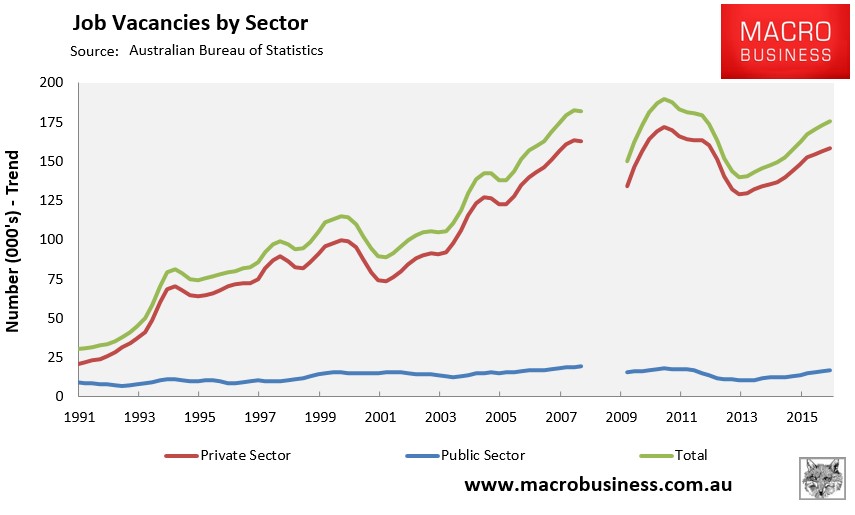It is Groundhog Day at the Australian Bureau of Statistics (ABS).
The organisation has already been savaged by funding cuts and jobs losses under the prior two governments (both Labor and Liberal), thus hampering its ability to perform its functions.
When the former Labor Government cut funding to the ABS by $20 million during the GFC, it reduced the scope and sample size of the both the Labour Force and Retail Trade surveys, significantly reducing their reliability. It also ceased the job ads survey, whose impact can clearly be seen in the next chart, where data is missing for the crucial post-GFC period. Thankfully, all surveys were later reinstated to their former glory.

Then under the Abbott Government’s first Budget, the ABS was forced to cut its expenditure by $50 million over three years, which led to 100 staff being cut from the organisation. This left the ABS to perform its functions using a reduced sample in some surveys, less staff, and an antiquated computer system.
The effects were most evident with respect to the monthly Labor force survey, whose sample size was reduced, resulting in some wild gyrations and erroneous figures, leading to widespread ridicule and condemnation from analysts and commentators, as well as damage to the ABS’ once esteemed reputation.
And of course more recently we witnessed the massive Census fail.
Today, Fairfax’s Peter Martin reports that the ABS is about to cut some critical surveys because it does not have sufficient resources:
On Thursday, its chief David Kalisch revealed it did “not have the resources to undertake all the activities that fall within our legislative mandate that our users would like”.
…it’s going after the monthly retail sales survey as well as those on housing and lending finance, and a number on international trade. It says it will consult with users about making them less frequent, which will make them less useful.
The Reserve Bank in particular relies on the monthly housing finance survey to give it a handle on what happens as soon as it moves interest rates…
Deloitte Access Economics director Chris Richardson says we’ll be able to live with the cuts “until we can’t”.
“Until the next financial crisis or whatever it is rolls through town and we’re desperately trying to get a pulse, or indeed find one, that’s when we’ll know what’s missing,” he says.
Many more surveys are up for axing altogether, unless user funding is secured, among them those on internet use, the experience of patients in hospitals, victims of crime, and the foreign ownership of agricultural businesses.
This is complete and utter madness. Timely and accurate data are vital to good decision making, and these cuts risk hampering the Government’s ability to formulate policy, the RBA’s ability to accurately read the economy and formulate monetary policy, as well as the public’s decision making and ability to evaluate policy. It is a retrograde move that will provide minimal cost savings at potentially great long-term cost to the Australian economy.
Cutting the housing finance survey, in particular, is lunacy. At a time when the Australian housing market is bubbley by any measure and the key foundation of the economy, and there is conflicting data around prices, we need accurate and timely data on mortgage lending more than ever.
Hopefully, cooler heads will prevail and the ABS’ funding will be boosted. Otherwise, the RBA and policy makers will be left in the dark during what is likely to be a massive structural adjustment over the next few years as various forces collide, both domestic and global.

